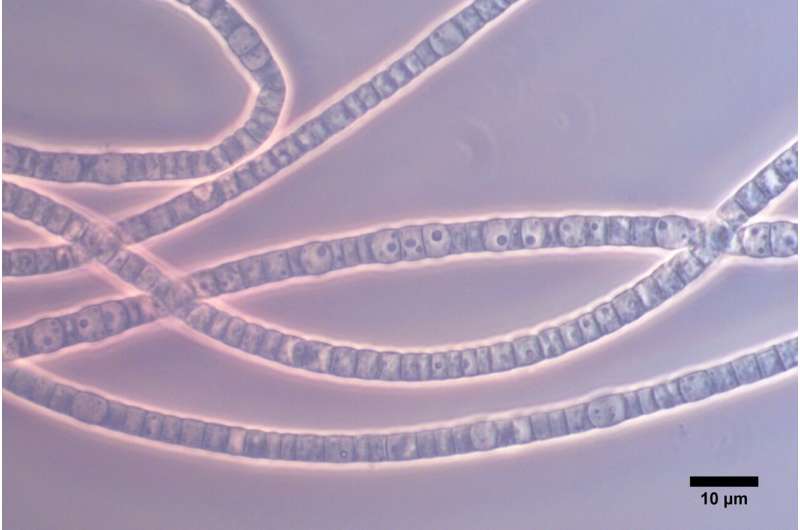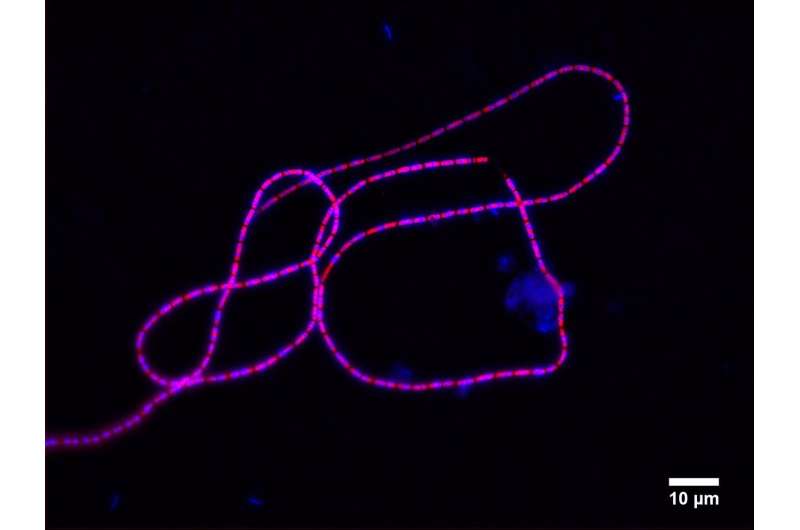Cable bacteria: Living electrical wires with record conductivity

A team of scientists from the University of Antwerp (Belgium), Delft University of Technology (Netherlands) and the University of Hasselt (Belgium) have reported on bacteria that power themselves using electricity and can send electrical currents over long distances through highly conductive power lines. Centimeter-long bacteria from the seafloor contain a conductive fiber network that operates in a way comparable to the copper wiring that used to transport electricity. The highly conductive fibers enable a completely new interface between biology and electronics, providing a prospect for new materials and technology.
Cable bacteria are centimeter-long micro-organisms that consist of thousands of cells in a row. "These multicellular bacteria were only discovered a few years ago, and we already knew they were doing something exceptional," explains team leader Prof. Filip Meysman (University of Antwerp). "Detailed investigations showed that electrical currents must be running through the seafloor, and all data suggested that the cable bacteria were generating and conducting these currents. Such an electricity-based metabolism would give the cable a huge advantage, being able to harvest energy from deeper layers within the seafloor." Although a tantalizing idea, there was no direct proof that cable bacteria were actually conductive.
The new study by the multi-disciplinary team of biologists, chemists and physicists now resolves this enigma. The scientists invented a procedure to extract a single bacterial filament out of the seafloor and attached this thin filament to a custom-made setup with tiny electrodes. "It took us great effort to connect the bacteria," explains Prof. Herre van der Zant, a physicist from Delft University of Technology. "But when we finally succeeded, the results were baffling. We saw that there was a large current going through this thin cable bacterium."

Bacterial power lines
The team then fine-tuned their procedure for handling the bacteria, and at one point, were able to show currents in a filament that was more than 1 cm long. "This extends the known length scale of biological electron transport by orders of magnitude, and implies that cable bacteria have found a mechanism to efficiently transport charges over centimeter-scale distances," says Prof. Jean Manca (University of Hasselt).
This observation presented another question: What are the conductive structures inside the bacteria that can sustain such high electrical currents? Advanced microscopy revealed that the cell wall of the cable bacteria contains a parallel network of fibers that run along the whole length of the bacteria. "We invented a kind of chemical car-wash procedure that removes cell material in a sequential fashion, and eventually only leaves the fiber structure behind," explains team leader Meysman.
"When we put this onto our electrode set-up, we again saw high currents, demonstrating that the fiber network in the cell wall is actually the conductive structure," says Prof. De Wael (University of Antwerp), who was responsible for the electrochemistry analyses in the project.
The electrical measurements revealed that the fibers sustained an extremely high electric current per unit of cross-sectional area, which readily compares to the current density that passes in the copper wiring of household appliances. Even more exciting, the conductivity of the fibers is unusually high, with values exceeding 20 S cm-1. For reference, this conductivity rivals that of the state-of-the-art conductive polymer materials used in flexible solar panels or foldable phones. "We were totally surprised when these high numbers first appeared on the display of our instruments," says Meysman. "Somehow, biological evolution has invented a structure with extraordinary electrical properties."
Bacterial smartphones
The discovery of the highly conductive fibers in cable bacteria is remarkable, as all known biological materials (like proteins, carbohydrates, lipids and nucleic acids) are extremely poor in terms of electrical conduction. The conductive fibers therefore provide a tremendous opportunity for new functional materials and technology, as the prospect of a bio-based material with exceptional electrical properties could push material science and electronics far beyond its current limits.
"The use of bio-materials in electronic engineering is an active field of research, for example, to achieve biodegradable electronics, which could reduce the problem of e-waste and allow greener consumer electronics. Or they could be applied in health care, where implantable diagnostic and therapeutic devices could function during a certain time frame and then disappear via resorption by the body," explains Meysman. "Maybe within some years, we will have medical implants or smartphones that are equipped with minuscule conducting wires of bacterial origin."
This study is published in the scientific journal Nature Communications.
More information: Filip J. R. Meysman et al. A highly conductive fibre network enables centimetre-scale electron transport in multicellular cable bacteria, Nature Communications (2019). DOI: 10.1038/s41467-019-12115-7
Journal information: Nature Communications
Provided by Delft University of Technology




















